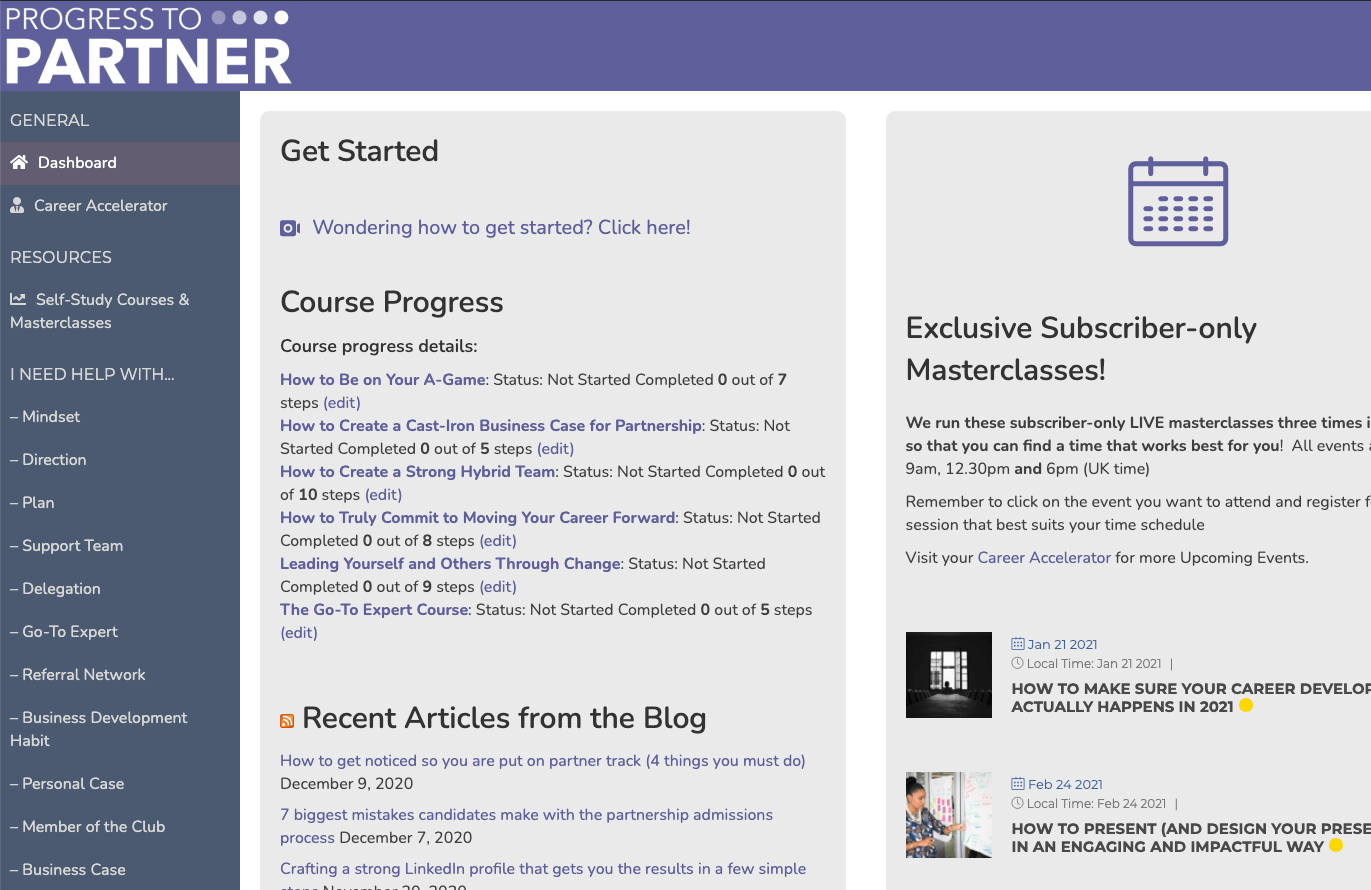You've completed the Partnership Readiness Assessment!
Congratulations! It's not a quick assessment to work though and the fact that you took the time means that you've shown some serious commitment already to developing yourself and your career.
The Partnership Readiness Assessment works to show you how ready you are for partnership and shows you the 12 key indicators, which if not addressed, will stop you from making Partner. If you haven't scored high or 'green' in any of the indicators these are the areas you need to be focussing on first to improve your chances of making it to partner.
How to use the results of your Partnership Readiness Assessment to prioritise what areas you need to develop first
The Partnership Readiness Assessment shows you exactly how you are doing against the 12 key indicators. We've put the key indicators in order of priority, which means you need to make sure that the first indicator, Mindset scores green, before moving on to make sure that the second indicator, Direction scores green, and so on. Once a key indicator is green, start focusing on the next key indicator.
Here are the key indicators in order of priority to work on:
Direction
Do you know what really makes you tick and what you stand for?
Plan
Do you have a career plan guiding you to do the right things at the right time?
Support Team
Do you have the right support team in place to help you go all the way?
Delegation
Do you have the right people to delegate to so you can free yourself up to focus on partner type responsibilities?
Go-To Expert
Are you widely known and seen as an expert in what you do? Does work come directly to you?
Referral Network
Have you built referral networks to supply you with enough of the right type of work?
Business Development Habit
Do you routinely do a bit of business development each day?
Personal Case
Do you match up against the criteria required for partners in your firm?
Member of the Club
Do your partners already think you are a partner? Do they trust you to deliver and have you as your business partner?
Business Case
Are you implementing a robust business plan to help you grow the profits of your firm?
Partnership Admissions Process
Have you prepared for each element of the process? Can you succinctly pitch your business case?
You can use Progress To Partner membership to help you address each of the 12 key indicators
We've set up the Progress to Partner Membership site so that it can be searched by key indicator:

This makes it really easy to find the on-demand courses, recorded masterclasses, guides or quick wins that correlate to the key indicator you're working on.
The rest of this guide will explore the 12 key indicators in more detail, and give you suggestions for resources from the membership site to help you with each of the key indicators.
How to create your Partner Track Plan using the results of your Partnership Readiness Assessment
Your results from the Partnership Readiness Assessment show you where you need to improve to increase your chances of making partner. If you are like most people when they take this assessment, you will have lots of areas to work on. And the natural temptation is to want to work on all of these areas at once.
When you try to focus on too many things your brain brings out your Too Hard Box and nothing gets done. So instead of trying to do lots of things to rectify the key indicators which are amber or red, you are just going to focus your Partner Track Plan on one thing to improve over the next 90 days, i.e. your ONE BIG FOCUS.
Your ONE BIG FOCUS is the one thing you want to change or achieve in the next 90 days to drive your career forward the most. It could be:
- A target, e.g. win £120k of my own work within the next 90 days
- An intangible, e.g. feel more confident
A ONE BIG FOCUS for the next 90 days works because:
- Setting goals is great for short term accountability and action
- It focused you on what you will do
- It keeps it really simple, which means you are more likely to achieve it
Now that your results are in...
If you have identified 2 or 3 different things, from your Partnership Readiness Assessment, which are all a high priority to drive your career forward, it is time to look at how these are linked. Then which of these are Outcomes and which are Actions. It is important to remember that you can not influence the Outcomes you want. You can only influence the Actions you take to achieve the Outcome.
For example, if your priorities are 'get more client work', 'release my time to work on my career', and 'delegate more', the only Outcome is 'get more client work'. The rest are Actions. The purpose of the Actions identified in this example are to create the time to win work. This means that the ONE BIG FOCUS is going to be related to 'get more client work'. So, when you specify your desired ONE BIG FOCUS, reframe it in terms of the Actions you will take to achieve it. I.e. what you can actually control and influence.
In this instance, your ONE BIG FOCUS would probably be something like this:
My ONE BIG FOCUS for the next 90 days is to find £120k of new work. To do this I will:
- Delegate more so I have the time to:
- Phone all of my contacts at clients who have instructed me in the last 12 months
- Allocate an hour each week to plan ahead so I can delegate more effectively and consistently to my team
- Manage my clients expectations better so they get the information I need back in good time
Once you have identified your ONE BIG FOCUS, you now want to break it down into goals to achieve by the end of 30, 60 and 90 days. Once those goals are identified, then break each of these down into 3 smaller monthly sub goals. Now you have these goals identified, it's time to create a Partner Track Plan to achieve these goals. It is recommended that you allocate some time each week to diarise exactly what you are going to achieve towards your ONE BIG FOCUS each week.
For example, A Partner Track Plan for the previous example could look like this:
ONE BIG FOCUS: By 30th Sept I will have won £120k of new client work
| Monthly Goal | Monthly Sub-Goals | Actions |
| Phoned Client A, B, C, D and E | Diarised 1 hour per week to plan my workload |
|
| Identify actions to free up my time |
|
|
| Call Client A, B, C, D and E |
|
|
| Phoned Client F, G, H, I and J | Run a training session with the team on xxx |
|
| Booked time in with Client F, G, H, I and J |
|
|
| Reduce amount of time chasing clients for information |
|
|
| Spend 3 hours a week on Business Development | Block out 3 hours a week for Business Development |
|
| Keep Business Development plan updated and actions diarised |
|
|
| Have 1 'networking' meeting with introducer per week |
|
Got stuck?
With so much to do and so little time it is really easy to get stuck creating or implementing your Partner Track Plan. If this is you, or you fear it could become you, then book a coaching call with one of the Progress To Partner Executive Coaches. This can be done through the dashboard of Progress To Partner or by emailing kate@excedia.co.uk. Progress to Partner members get a discount on coaching fees.





